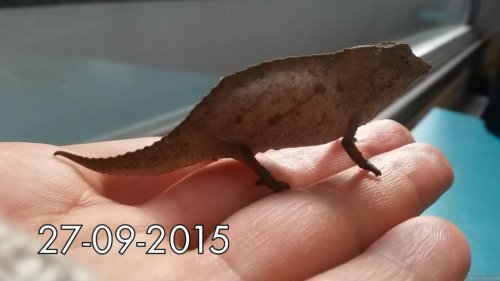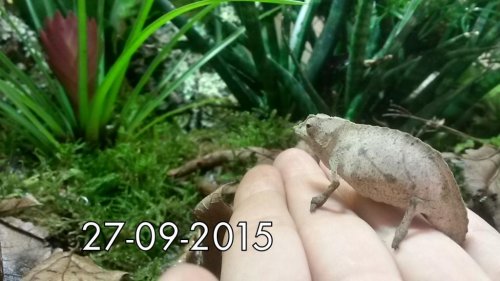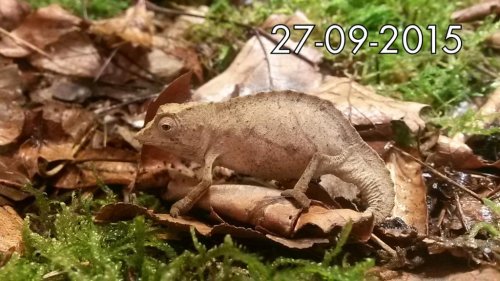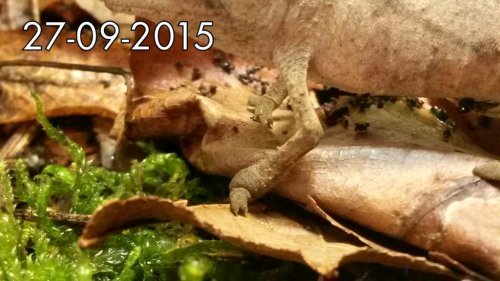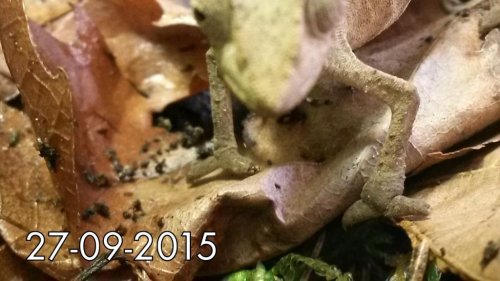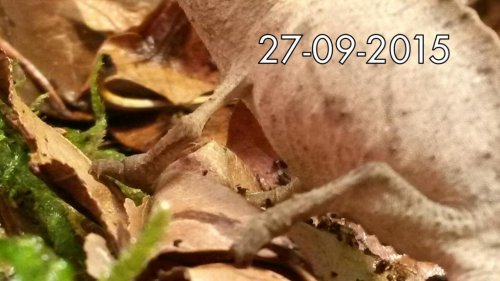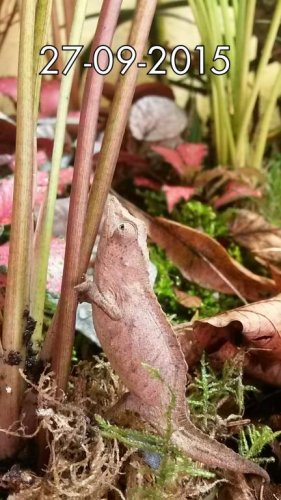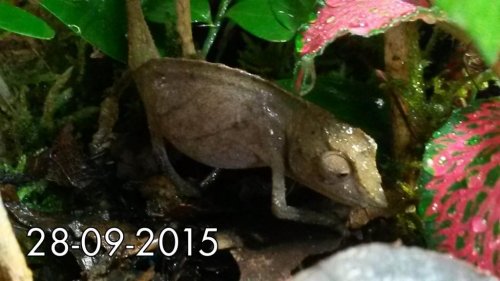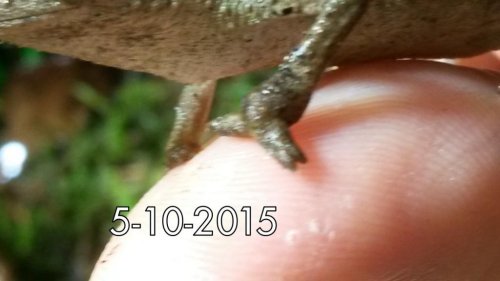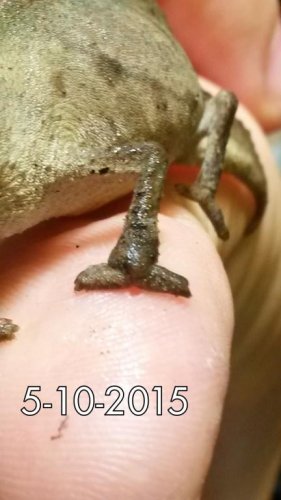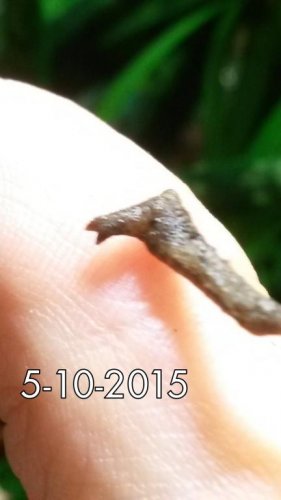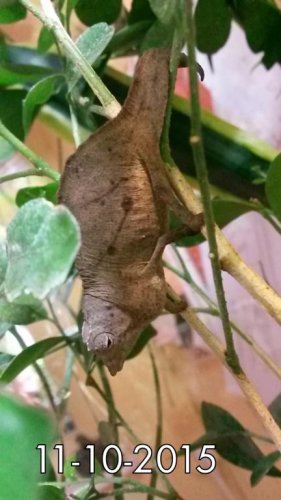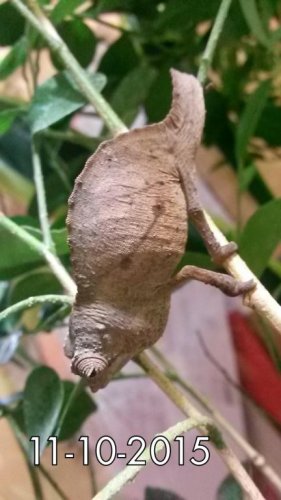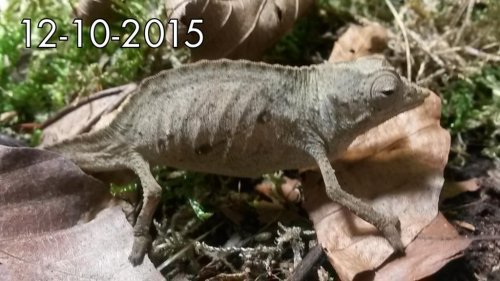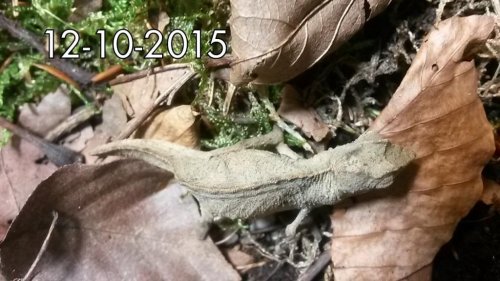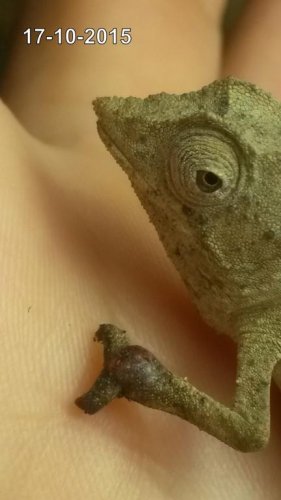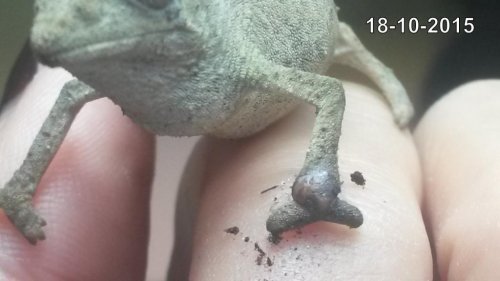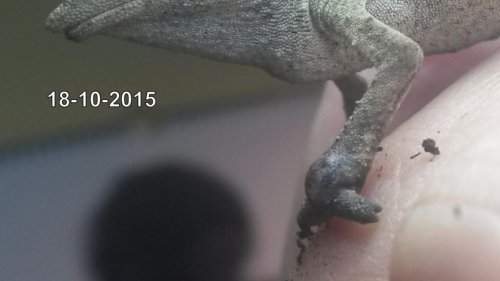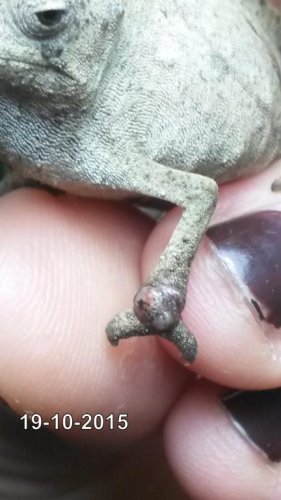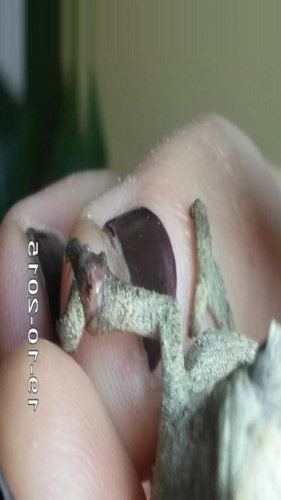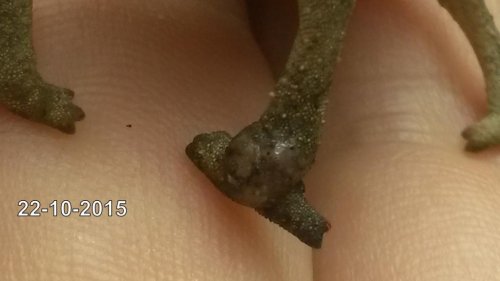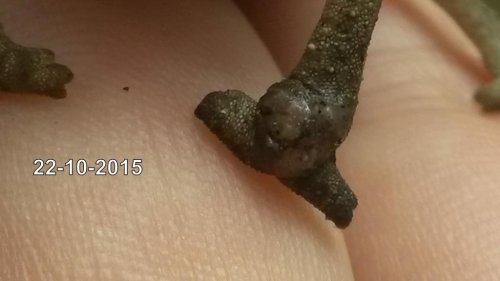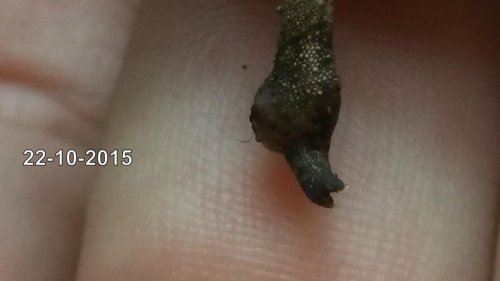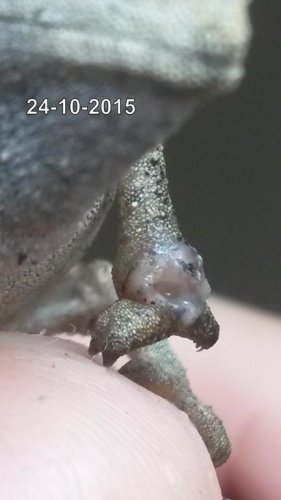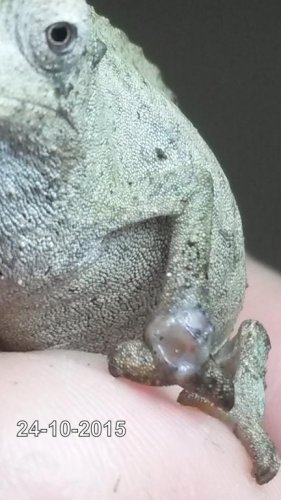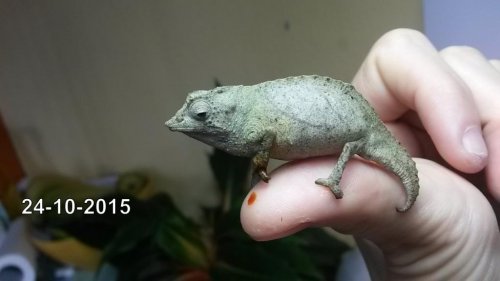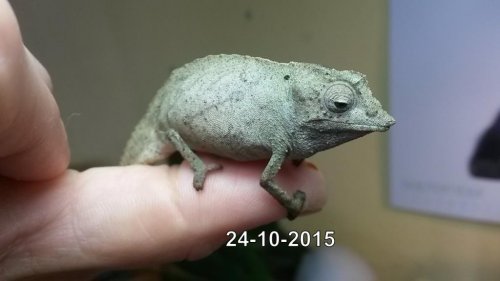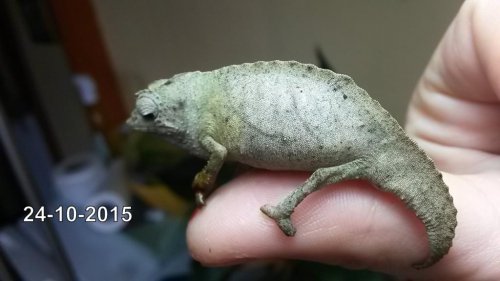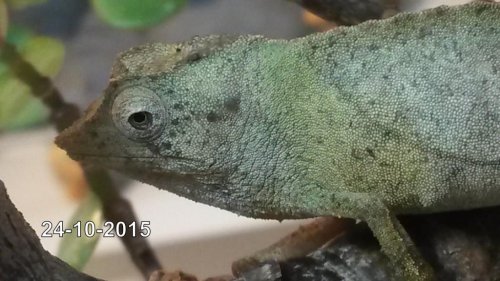aeolis23
Member
The Problem –
I bought my chameleons on 27/09/2015 at a reptile fair in Belgium (first picture is taking on my way home). I saw the male’s paw was swollen but bought him anyway and went to the vet with him. I was concerned about it being gout or an infection.
Verdict from the vet:
* IN GENERAL my cham didn’t look very active, but I had to take him out of the viv when the lights were still off and he was still sleeping (vet appointment was very early in the morning). He also was only in my care for about 2 days, so wasn’t adjusted to the new environment yet.
* THE PAW: he took fluid from the thickened paw and didn't find any gout cristals, so the vet assumed it was not gout with about 80-90% certainty. He did find lots of bacteria in the fluid, so he's guessed a systemic infection that probably is also manifested on his intestines.
--->Treatment: 14 days of antibiotics (Enroshort), each day.
Note: Could also be fungus, but he didnt find any in the fluid. Unfortunately not all fungus are microscopically visible, so he could not exclude all fungus. There is a fungus discovered a few years ago that also manifests on the joints and he warned me that if he would have this fungus, it'll be only visible once he's almost dead and then it's too late...
* FAECES: He found massive amounts of parasites and worms. No coccidiosis.
---> Treatment: 4 days of flagyl, repeat after 14 days + 1 time panacure, repeat after 14, 21 and 28 days.
Current situation:
- No improvement of the paw.
- I quit the antibiotics treatment after about 11 days.
- I should give him flagyl and panacur again one of these days, but haven’t done it yet.
Even more…
- His neck is very swollen since the last few days.
- He just doesn’t look healthy at all…
I already contacted the vet again. He also told me to stop with the antibiotics and come back to make cultures from the fluid in the paw. I can only make it to the vet in 5 days (on friday) so all the help possible is welcome.
I wrote the date with the pictures when they were taken.
*************************************************
Chameleon Info:
• Your Chameleon –
o R. temporalis
o Male
o Adult (age unknown)
o Wild caught
o In my care for 2 weeks
• Handling –
o I had to handle him every day the last 2 weeks to give him antibiotics, but I quit treatment 2 days ago and i’m leaving him alone now.
• Feeding –
o Feeders: Mainly crickets, occasionally locust
o I throw in about 5 crickets per chameleon every 2 days
o My crickets get the cricketfood they got when I bought them and fruit/vegetables.
• Supplements –
o Repco Vita-Totaal
o Zoo Med’s ReptiVite TM without D3
o Exo Terra Calcium + D3
o Each time I put new crickets in the terrarium, I first put 2 volumes of Vita totaal + 1 volume of Ca without d3 + 1 volume of Ca with d3 in a pot, put the crickets in the pot and shake untill the crickets are completely white with powder.
• Watering –
o I spray manually each day untill the plants are soaked with water drops.
o I have seen him drinking once from the moss on the bottom (picture of that moment in the attachment 28-09-2015)
• Fecal Description –
o Recently no faeces found
o 2 weeks ago he was tested and the vet found tons of parasites and worms.
o He already had 4 days Flagyl treatment 2 weeks ago, and I had repeat one of these days.
o He already had 1 day Panacur 2 weeks ago and I had to repeat one of these days and again next week.
Cage Info:
• Cage Type –
o 80x40x60 cm horizontal terrarium
o glass terrarium with one door replaced by mesh to improve ventilation
• Lighting –
o Exo Terra Reptile UVB 100 25W. In use since 8/03/2015.
o Exo Terra Natural Light UVA 25W. In use since 20/06/2015.
o Lights are on from 8h30 – 21h30.
• Temperature –
o During the day between 18 – 25°C (64.4 – 77°F)
o During the night between 15 – 18°C (57.2
o I measure with a standard mercury termometer in the terrarium on the warmest spot of the room.
• Humidity –
o Between 70 – 90 %
o There is an Exo Terra manual meter in the lower corner of the viv.
o There never is a "extra" water in the drainage layer.
• Plants –
o Live plants, pottet freely in the bottom layer. There is a drainage layer of hydroballs seperated from the earth above by a root cloth.
• Placement –
o Located between the wall, only the back of the terrarum is covered.
o No movement on the right sides unless I put my head there to find them.
o Often movement on the left side.
o The viv in on eye height in the room.
• Location –
o Belgium
• Extra -
o There is one female with him in the viv. She was bought at the same time, same place, same seller. Their were introduced in the viv together. Not sure if the female is healthy either…
I bought my chameleons on 27/09/2015 at a reptile fair in Belgium (first picture is taking on my way home). I saw the male’s paw was swollen but bought him anyway and went to the vet with him. I was concerned about it being gout or an infection.
Verdict from the vet:
* IN GENERAL my cham didn’t look very active, but I had to take him out of the viv when the lights were still off and he was still sleeping (vet appointment was very early in the morning). He also was only in my care for about 2 days, so wasn’t adjusted to the new environment yet.
* THE PAW: he took fluid from the thickened paw and didn't find any gout cristals, so the vet assumed it was not gout with about 80-90% certainty. He did find lots of bacteria in the fluid, so he's guessed a systemic infection that probably is also manifested on his intestines.
--->Treatment: 14 days of antibiotics (Enroshort), each day.
Note: Could also be fungus, but he didnt find any in the fluid. Unfortunately not all fungus are microscopically visible, so he could not exclude all fungus. There is a fungus discovered a few years ago that also manifests on the joints and he warned me that if he would have this fungus, it'll be only visible once he's almost dead and then it's too late...
* FAECES: He found massive amounts of parasites and worms. No coccidiosis.
---> Treatment: 4 days of flagyl, repeat after 14 days + 1 time panacure, repeat after 14, 21 and 28 days.
Current situation:
- No improvement of the paw.
- I quit the antibiotics treatment after about 11 days.
- I should give him flagyl and panacur again one of these days, but haven’t done it yet.
Even more…
- His neck is very swollen since the last few days.
- He just doesn’t look healthy at all…
I already contacted the vet again. He also told me to stop with the antibiotics and come back to make cultures from the fluid in the paw. I can only make it to the vet in 5 days (on friday) so all the help possible is welcome.
I wrote the date with the pictures when they were taken.
*************************************************
Chameleon Info:
• Your Chameleon –
o R. temporalis
o Male
o Adult (age unknown)
o Wild caught
o In my care for 2 weeks
• Handling –
o I had to handle him every day the last 2 weeks to give him antibiotics, but I quit treatment 2 days ago and i’m leaving him alone now.
• Feeding –
o Feeders: Mainly crickets, occasionally locust
o I throw in about 5 crickets per chameleon every 2 days
o My crickets get the cricketfood they got when I bought them and fruit/vegetables.
• Supplements –
o Repco Vita-Totaal
o Zoo Med’s ReptiVite TM without D3
o Exo Terra Calcium + D3
o Each time I put new crickets in the terrarium, I first put 2 volumes of Vita totaal + 1 volume of Ca without d3 + 1 volume of Ca with d3 in a pot, put the crickets in the pot and shake untill the crickets are completely white with powder.
• Watering –
o I spray manually each day untill the plants are soaked with water drops.
o I have seen him drinking once from the moss on the bottom (picture of that moment in the attachment 28-09-2015)
• Fecal Description –
o Recently no faeces found
o 2 weeks ago he was tested and the vet found tons of parasites and worms.
o He already had 4 days Flagyl treatment 2 weeks ago, and I had repeat one of these days.
o He already had 1 day Panacur 2 weeks ago and I had to repeat one of these days and again next week.
Cage Info:
• Cage Type –
o 80x40x60 cm horizontal terrarium
o glass terrarium with one door replaced by mesh to improve ventilation
• Lighting –
o Exo Terra Reptile UVB 100 25W. In use since 8/03/2015.
o Exo Terra Natural Light UVA 25W. In use since 20/06/2015.
o Lights are on from 8h30 – 21h30.
• Temperature –
o During the day between 18 – 25°C (64.4 – 77°F)
o During the night between 15 – 18°C (57.2
o I measure with a standard mercury termometer in the terrarium on the warmest spot of the room.
• Humidity –
o Between 70 – 90 %
o There is an Exo Terra manual meter in the lower corner of the viv.
o There never is a "extra" water in the drainage layer.
• Plants –
o Live plants, pottet freely in the bottom layer. There is a drainage layer of hydroballs seperated from the earth above by a root cloth.
• Placement –
o Located between the wall, only the back of the terrarum is covered.
o No movement on the right sides unless I put my head there to find them.
o Often movement on the left side.
o The viv in on eye height in the room.
• Location –
o Belgium
• Extra -
o There is one female with him in the viv. She was bought at the same time, same place, same seller. Their were introduced in the viv together. Not sure if the female is healthy either…


